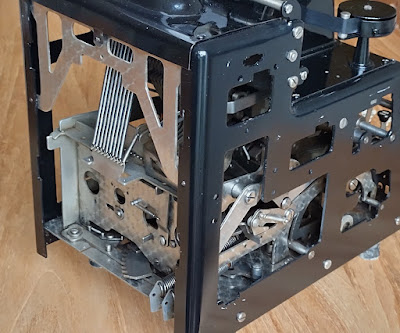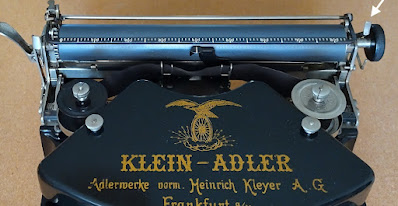After some experimenting (and many failures), the workflow for creating new Hammond typeshuttles is starting to form.
A new Hammond typeshuttle is assembled from several parts, just like the original. The individual parts have to be modelled, manufactured, finished and then assembled.
The core of the original shuttles (above) were two nickelsilver strips; one as flange to ride in the slot of the anvil and one curved 'vertical' that was embedded in the vulcanised rubber. The vulcanised rubber is the actual black bit of the shuttle that contains the characters or typeslugs, impressed from the mold. A small metal 'grip' collar was fastened with two rivets to the flange as take-up for the machine's driver-arm. An original Hammond shuttle could thus be seen to be made up of 6 different parts. These parts and materials all have different properties - also needed for their function.
In re-creating a Hammond-compatible typeshuttle is is also necessary to build it up from different materials, with different properties.
Build-up of new shuttle
The new typeshuttles are built up of the shuttle-strip that contains the characters, a steel flange and a small take-up collar. The 3 parts are glued together, optionally held in a jig for correct shape and alignment.
Grip
The small take-up collar or grip is 3D-printed in PLA material on an FDM printer. Using a 0.2 mm nozzle, a precise and fine part is printed, with PLA being very strong at room-temperature and highly impact-resistant. The part is small, so even with a 0.2mm nozzle the printing is fairly fast. Optimal results from printing by-object, no finishing should be needed.
Flange
The steel flange is laser-cut from 0.2 mm stainless steel. These were ordered from a local shop, that does lots of laser-cutting. The parts are perfectly flat and were cut with an industrial-quality machine under protective gas so no cleaning or finishing is needed. Ordering a batch of these can make it quite reasonable and relatively affordable. (I.e. in the context of a Hammond typewriter :-)
Assembly jig
The assembly jig is optional; the grip, flange and strip have alignment features that enable correct assembly. For especially the resin-printed strips however, it may be essential to re-shape these with the jig. Resin-prints have residual tension and the curvature of the part as it emerges from the printer after cleaning off any supports is not reliably correct! The jig is not too critical and can be simply printed with a 0.4 nozzle on any FDM printer.
The model-files for these parts can be downloaded here.
Shuttle strip
The shuttle strips with characters are generated using a scripted 3D modeller. There are several of these programs, in this case OpenSCAD was used. The script was created for the current 'stable' release and everything was kept in one file without external dependancies (except of course the font-file). This should make it reasonably robust and easy to get working anywhere to generate a printable model. (Development-builds have some new features that could really help in creating better, nicely aligned, monospaced type.)
The script contains already a couple of layouts, selectable by uncommenting a single line further down. This selection-line also includes several extra parameters, optimized for that specific layout (the obvious one being number of rows). Some of the available layouts illustrated in 'preview', i.e. not yet with the type mirrored:
The script also contains lines for selecting a typeface, a font file that has to be present on the computer and available to OpenSCAD. This can be 'tricky' and may require tweaking to properly fit all the characters on the shuttle. Not every font contains all characters (glyphs) that are needed for a layout. Fontfiles also contain errors; the character may display fine on screen, but a small error can prevent the character from being able to be generated as a 3D typeslug.
Generating the actual, correct 3D model from the script is a computationally intensive task. Even on a fairly fast computer it will take several minutes, up to half an hour - depending on the complexity of the typeface. Every character is generated from the glyph in the fontfile with a tapered base. This taper is done for strength, naturally, and also to enable the 3D printing process to generate the shapes (limit overhang-angles).
There is the option in the script to generate a file for resin-printing - permitting fine detail - or for FDM printing with additional bed-adhesion features. The model generated for FDM also contains modifications to the 3D model geometry to compensate for limitations of the FDM process itself.
The shuttle strips will need some finishing after they've been printed; supports and adhesion-feet will need to be removed. Any remaining marks should be sanded smooth. Especially the inner curved surface must be made very smooth and clean; this has to slide over the anvil. FDM-printed strips in PLA are generally pretty good on dimensions and have the correct curvature, but resin-printed strips will need some time in the assembly jig to be 'bent' back into shape - the material does relax and settle in the correct shape after an hour or so.
The STL 3D-model file for an English Universal shuttle strip with a regular Roman typeface can be downloaded here for resin-printing and the file for FDM printing with a fine, 0.2 mm nozzle can be downloaded here.
The OpenSCAD script file has embedded comments that should help understanding what everything does, and what parameters to change when creating new shuttle models. It also should make is fairly easy to expand and adapt for new layouts or otherwise improve upon. The version of the shuttle strip script used to generate the above models can be downloaded here. (Whilst it is commented, the code itself is not very good. There is sloppy parameter-passing, many variables are global and used throughout. The code could do with re-factoring and probably be optimised for speed. I.e. options aplenty to tinker and improve - but it works. My Mignon type-cylinder code is much cleaner, having learned :-)
Assembly of the typeshuttle
Having a properly smoothened strip, a flange and a grip, these can be placed in the jig.
To fix the parts, a drop or two of cyanoacrylate glue are applied with a toothpick to where the flange sits in the strip's groove.
Capillary action and some help from a scrap bit of card will spread the glue over the entire length of the shuttle. (Picture below was taken when the ends still needed a proper push into the groove.) Despite its reputation as fast-setting, allow several minutes (hours!) for the cyanoacrylate to properly harden out.
If everything went fine, then the newly assembled typeshuttle should fit on the anvil on a Hammond typewriter. It should slide around freely without any binding. If there is binding, the shuttle strip may be a bit deformed and need further sanding - this is actually fairly likely with resin-printed strips, FDM strips usually are fine as are. The grip may also need a bit of smoothing on the side it runs against the inside of the anvil - e.g. run a bit of sandpaper (180 grit) through the shuttle against the sides to smoothen all surfaces.
With all this done, the Hammond typewriter has another typeface added to its repertoire ;-)
As warned by the Hammond company; do not use oil on the shuttles - if wanting to lubricate, perhaps apply a little talcum powder. It should run fine without any lubrication though.
In conclusion
With the above workflow, new typeshuttles can be made for the Hammond typewriter. It thus becomes possible to use the antique machine without risk of damaging an old, original typeshuttle. The original shuttle's hard-rubber is relatively brittle and can easily crumble or chip. It's also possible to re-create shuttles with otherwise rare typefaces or layouts - or make shuttles with completely new layouts and typefaces.
Creating these new typeshuttles was only possible by building on top of the awe-inspiring work done in making new Selectrix typeballs; especially the work and example code of Dave Hayden of selectricrescue.org was instrumental in getting things this far. Sharing experiences and discussing designs with Leonard Chao really helped getting it all to work. He's been doing amazing work on 3D printing new Blickensderfer cylinders and Hammond shuttles too!
And of course made possible by open-software design tools OpenSCAD and FreeCAD.
The ability to make new shuttles should enable Hammond typewriters to continue typing far into the 21st century; usable Hammond typewriters! :-)













































